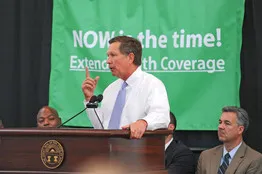Governor Kasich: No Right to Work for Ohio

Ohio Governor Kasich has caved to Big Labor demands to keep Ohio workers under union rule. The Wall Street Journal’s Neil King, Jr., has the story.

Governor Kasich
Job growth is up. The Republican governor just signed what he calls “the biggest tax cut in the country” after converting a looming $7.7 billion budget deficit into a $2.5 billion surplus. Such success, he says, “would probably get a global CEO a giant bonus.”
Then comes the part that sets Mr. Kasich apart.
As his party continues to seek a new footing after its national election losses last year, Mr. Kasich is blunt about his own aims for the GOP as he eyes a re-election fight next year and—some speculate—a possible run for the White House in 2016. Asked about that, his office said he is focused on improving the state.
“I have a chance to shape what it means to be a Republican,” Mr. Kasich said in an interview wedged between a ribbon-cutting ceremony for a new factory and a rally supporting an expansion of Medicaid, the federal-state health-care program for the poor and disabled. “I have a chance to show what it means to be successful economically but also to have a compassionate side, a caring side, to help lift people up,” he said.
Mr. Kasich’s efforts, which his critics dismiss as an opportunistic bid to boost his once-abysmal poll numbers, come as many fellow Republican governors are pursuing sharply conservative agendas, empowered by GOP control of legislatures. Of the 30 Republican governors, just five so far have embraced and put in motion the Medicaid expansion envisioned by the health-care overhaul.
If Mr. Kasich wins re-election next year, supporters say, he could provide his party with its most extensive model for a softer brand of conservatism. “John is showing, perhaps more visibly than anyone, that conservatives can care deeply about those who are overlooked and are at risk of being left behind,” said Ed Gillespie, a former national Republican Party chairman. “This is a very important thing for our party to demonstrate.”
Evidence so far shows Mr. Kasich benefiting from his strategy. A June Quinnipiac poll showed his approval notching a new high at 54%, versus 36% in the fall of 2011. A third of Ohio Democrats said they approved of his performance, nearly triple the share from 2011.
Mr. Kasich has lost little of the brusqueness that characterized his years as the U.S. House Budget Committee chairman in the late 1990s. When a conservative Ohio lawmaker questioned his quest to expand Medicaid, Mr. Kasich cut him off with a line he has used often since then.
He began his governorship in early 2011 by supporting an existing bill to limit the collective-bargaining rights of public-sector unions. The move drew praise in conservative circles but also provoked a backlash, including from many working-class Republicans. A voter rebellion resoundingly overturned the law a few months later, and Mr. Kasich became one of the least-popular governors in the country.
Mr. Kasich says he has put the issue behind him. “We lost, and you have to listen to what people want,” he said.
Since then, he has worked to reach out to groups well beyond his conservative base.

